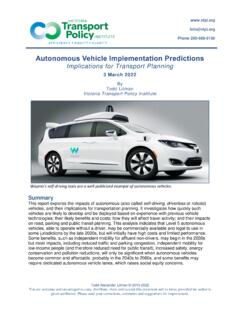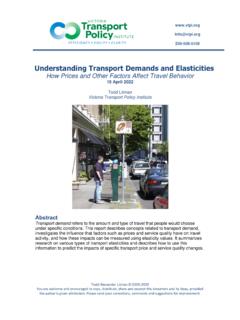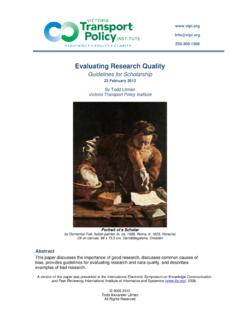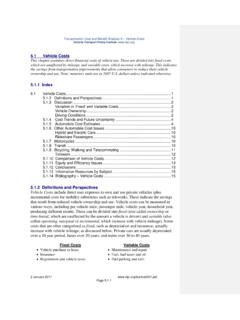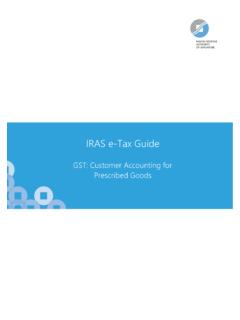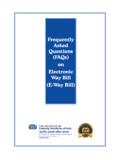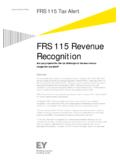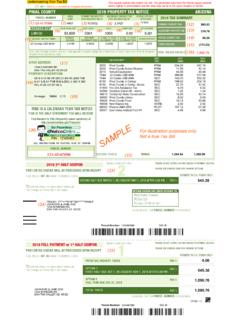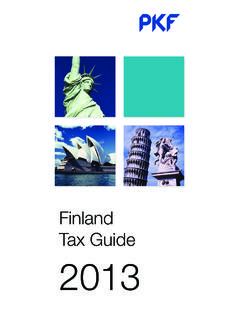Transcription of Evaluating Transportation Economic Development …
1 250-360-1560 Todd Litman 2010-2017 You are welcome and encouraged to copy, distribute, share and excerpt this document and its ideas, provided the author is given attribution. Please send your corrections, comments and suggestions for improvement. Evaluating Transportation Economic Development Impacts Understanding How Transport Policy and Planning Decisions Affect Employment, Incomes, Productivity, Competitiveness, Property Values and Tax Revenues 18 July 2017 Todd Litman Victoria Transport Policy Institute Transportation planning decision affect Economic Development in many ways: by influencing the connections between resources, workers, businesses and customers; by influencing consumer expenditures; and by affecting land use Development location and intensity. Abstract Economic Development refers to progress toward a community s Economic goals such as increased employment, income, productivity, property values, and tax revenues. This report examines how Transportation policy and planning decisions affect Economic Development , methods for Evaluating these impacts, and ways to maximize Economic Development benefits in transport decisions.
2 Some of these impacts are often overlooked in conventional analysis. This report was summarized in: Economically Optimal Transport Prices and Markets: What Would Happen If Rational Policies Prevailed? presented at the International Transportation Economic Development Conference, 2014 in Dallas, Texas ( ); at Evaluating Transportation Economic Development Impacts Victoria Transport Policy Institute 1 Contents Executive Summary .. 2 Introduction .. 10 How Transportation Affects Economic Development .. 12 Transportation Productivity Trends .. 22 Mobility, Vehicle Travel and Economic Development .. 27 How Vehicle Travel Affects Economic Productivity .. 28 Automobile Transportation Productivity .. 39 Mobility Management Economic 41 Evaluating Specific Economic Development Impacts .. 45 Transportation Program Expenditures .. 45 Consumer and Business Expenditures .. 48 Transportation Project Cost Efficiency .. 51 Transport System Efficiency .. 52 Roadway Improvements.
3 54 Public Transit Service Improvements .. 58 Basic Mobility - Employment Access .. 60 Retail and Tourism Industries .. 60 Impacts on Specific Industries and Businesses .. 62 Land Use Economic Productivity Impacts .. 63 Property Values and Development .. 66 Affordability .. 67 Household Wealth Accumulation .. 68 Desirable Outcomes .. 69 Economic Development impact Analysis Summary .. 70 Transportation Economic Development Strategies .. 72 Improve Transport System Efficiency .. 72 Transportation Planning Reforms For Efficiency .. 73 Employment and Income Growth .. 74 Property Values .. 75 Affordability and Basic Accessibility .. 75 Evaluation Methods .. 78 Examples and Case Studies .. 82 Downtown Parking Subsidies .. 82 Roadway 84 Public Transportation Investments .. 85 Transportation Pricing Reforms .. 88 Automobile-Oriented Versus Transit Oriented Development Expenses .. 90 Multi-Modal Transportation Economic Development Benefits .. 92 High Speed Rail Economic Benefits (Ahlfeld and Feddersen 2010).
4 93 Sustainable Transportation Economic Evaluation .. 93 Automobile Industry Subsidies .. 93 Bicycle Improvement Benefit/Cost Analysis (Gotschi 2011) .. 95 Best Practices .. 96 Conclusions .. 99 References and Resources .. 101 Evaluating Transportation Economic Development Impacts Victoria Transport Policy Institute 2 Executive Summary Economic Development refers to progress toward a community s Economic goals such as increased employment, income, productivity, property values, and tax revenues. Transport policy and planning decisions can affect Economic Development in various ways, including some that are indirect and long-term. Conventional transport Economic evaluation tends to recognize some of these impacts but overlook others. Some guidebooks and software tools exist for Evaluating Transportation Economic Development impacts, but most can only evaluate a limited range of modes, impacts or project types. Few tools can evaluate the full Economic impacts of mobility management and smart growth policies and programs.
5 This has important implications for transport policy and planning decisions. Theoretical and empirical evidence indicates that once a region has a basic paved roadway system, further roadway expansion provides declining marginal benefits, while investments in alternative modes and mobility management generally provide greater Economic returns. Similarly research indicates that efforts to minimize vehicle, road, parking and fuel prices (through low taxes, and direct and indirect subsidies) reduces Economic competitiveness and wealth generation. In addition, research also indicates that excessive land use sprawl creates Economic costs. Described differently, sustainable transport planning balances Economic , social and environmental objectives. Comprehensive Economic impact analysis is essential for true sustainability planning, similar to comprehensive evaluation of social and environmental impacts. This helps identify win-win solutions, which are policy and planning decisions that help achieve Economic , social and environmental objectives together.
6 Evaluating Transportation Economic Development Impacts Victoria Transport Policy Institute 3 How Transport Impacts Economic Development To evaluate the Economic impacts of transport policy and planning decisions it is useful to consider the specific mechanisms by which transport can affect Economic activity. There are often several steps between a particular planning decision and its ultimate Economic impacts, as summarized below. Comprehensive Economic analysis must consider these various impacts and outcomes. Transport Policy or Planning Decision (investments, management changes, pricing reform, smart growth land use policy, etc.) Intermediate Impacts (changes in infrastructure supply efficiencies, transport costs, land use, external costs, consumer expenditures, etc.) Economic Development Outcomes (changes in Economic productivity, employment, affordability, etc.) Types of Economic Impacts Major categories of Economic impacts are described below. Accessibility Accessibility (the ability of people and businesses to reach goods, services and activities) affects productive activities (education, work, manufacturing, trade, etc.)
7 , so improving accessibility tends to increase productivity. Access can be improved by reductions in shipping costs, travel time, vehicle operation, and infrastructure, and by using resources more efficiently by favoring higher value travel over lower value travel (for example, by favoring freight over personal transport on congested roadways). Indirect and external costs Traffic congestion, road and parking facility costs, accident and pollution damages tend to reduce Economic productivity. Reductions in these costs support Economic Development . More efficient land-use Development patterns More compact, mixed, connected land use Development patterns tend to improve overall accessibility, increase agglomeration efficiencies, and increase productivity, for example, by making more land available for agriculture. Consumer expenditures How consumers spend money affects Economic activity in an area. Some goods provide more regional employment and business activity than imported goods.
8 Supports specific industry A particular transport service or activity may affect a particular industry. Improving that type of transport can support those industries, which may support strategic Economic Development . For example, improving visitors ability to reach an area supports tourist industries, and improving customer access supports local retail industry. Evaluating Transportation Economic Development Impacts Victoria Transport Policy Institute 4 The table below summarizes these mechanisms and the degree that they are considered in conventional transport planning. Table ES-1 Types of Transport Economic Impacts Mechanism Examples Degree Considered in Planning Accessibility and transport costs Paving roads, reducing congestion, improving transit service. Generally considered for motor vehicle improvements, particularly increased motor vehicle traffic speeds and reduced vehicle operating costs. Reduced external costs Policies and programs that reduce congestion, accidents, pollution emissions.
9 Sometimes considered. Efficient land use Road and parking facility expansion, and reduced vehicle operating costs tend to stimulate sprawl, while walking and public transit improvements support more compact Development . Generally ignored. Expenditure impacts Per capita expenditures on transport vehicles and fuel. Generally ignored. Supports specific industries Certain industries are particularly affected by transport activities. Often considered if that industry is considered important in a community. This summarizes ways that transport policy and planning decisions affect Economic Development . Since industries and areas vary in the types and amount of Transportation they require, a particular transport policy or project may have very differing impacts on their productivity and Development . For example, for natural resource and bulk retail industries, freight transport is a major portion of production costs, so changes in freight transport speeds and costs can have a major impact on their productivity and profits, and Economic Development in communities where they are located.
10 For service industries (retail, restaurants, hotels, etc.), commuting costs, and therefore businesses ability to attract and retain suitable employees, can have significant impacts on their productivity and profits. Even small differences in such costs can affect a business or area s competitiveness if others. Some of these impacts reflect net Economic efficiency and productivity gains. Others are Economic transfers; one business or industry gains but another loses an equal amount. For example, improving access in a commercial area (such as government supplied parking or better public transit service) may benefit local businesses but does not necessarily increase total regional Economic activity, without the improvements consumers would have purchased the same goods in a different location. Overall Economic impacts often depend on whether a particular transport improvement increases overall productivity (for example, reducing retail activity labor costs) or supports strategic Development (for example, by supporting a growing industry such as tourism).
